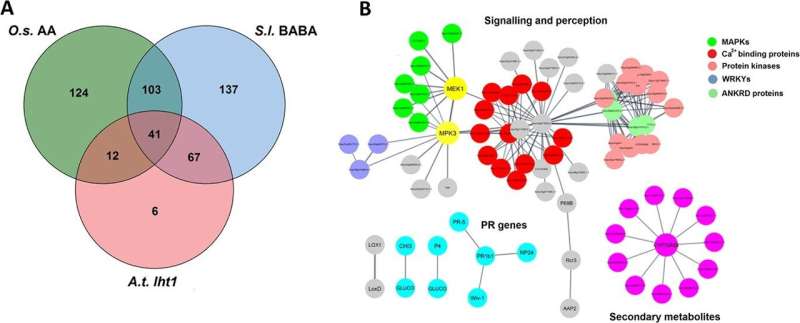This article has been reviewed according to Science X's editorial process and policies. Editors have highlighted the following attributes while ensuring the content's credibility:
fact-checked
peer-reviewed publication
trusted source
proofread
Unlocking BABA-induced resistance in tomato: A comprehensive multi-omics analysis

Plants have always been susceptible to various environmental stresses and attacks by pests and pathogens. Over time, they have evolved multiple defense mechanisms to repel potential attackers. However, the basal immune responses typically only slow down the colonization of pathogens, ultimately leading to significant global losses in plant production caused by fungi, oomycetes, bacteria, insects, and nematodes.
Fortunately, when exposed to microbe-associated molecular patterns (MAMPs) or specific chemical compounds, plants can enter a state of enhanced defense through "defense initiation." Defense priming can activate multigenic defense mechanisms, conferring relatively durable resistance. One of the most effective priming agents is the non-protein amino acid β-aminobutyric acid (BABA), which protects various plant species against a wide range of stresses.
BABA is an endogenous stress metabolite ,which induces resistance through the action of several hormones, including salicylic acid (SA), jasmonic acid (JA), abscisic acid (ABA) and ethylene (ET). As tomato is an important crop globally, it is of great significance to gain insight into the molecular basis of BABA-induced resistance in tomato.
Horticulture Research published a research paper entitled "BABA-induced pathogen resistance: a multi-omics analysis of the tomato response reveals a hyper-receptive status involving ethylene".
To understand the protective effect of BABA on tomato plants against various pathogens, plants were treated with 10 mM BABA and then exposed to biotrophic Oidium neolycopersici, hemibiotrophic Phytophthora parasitica, and necrotrophic Botrytis cinerea. The results showed that BABA treatment significantly reduced the sporulation of O. neolycopersici and the spreading of P. parasitica but had no effect on B. cinerea.
Subsequently, transcriptomic and proteomic analyses were performed 24h and 48h after BABA treatment. RNA sequencing identified 24,562 genes, of which 1,523 genes were differentially expressed. The proteome analysis identified 1,808 protein groups and 319 differentially expressed proteins.
As with the transcriptome, far more proteins were up-regulated (67%) than down-regulated (33%) after BABA treatment, but the correlation between proteins and transcripts changes was only about 10%. These results suggest that BABA treatment leads to extensive reprogramming of cellular processes in tomato.
By comparing different RNA-seq data, it was found that almost 50% of the BABA-upregulated genes were also differentially regulated during MAMPs-triggered immunity (MTI), suggesting that BABA treatment exhibits common features with MTI.
They also compared the set of BABA-upregulated genes with the set of genes upregulated in transcriptomics studies performed on tomato plants subjected to temperature, salinity stress, and infected by the fungus Stemphylium lycopersici and the FIRE. It was found that 50% of the BABA upregulated genes overlapped only with the set of genes up-regulated by abiotic stresses, confirming BABA primarily acts as a stress factor in tomato plants.
Researchers further performed KEGG and Gene Ontology (GO) term analysis to investigate the molecular mechanisms underlying the BABA stress response. The results showed a significant enrichment of genes related to the JA and ET signaling pathways. Moreover, both ET and JA accumulated in tomato plants during the first few hours after BABA treatment. Accordingly, the specific genes crucial for ET and JA biosynthesis were upregulated post-BABA treatment.
There was no significant enrichment of genes related to the phytohormone SA, but rather a slight decline in SA levels in BABA-treated leaves. Additionally, BABA treatment did not significantly influence genes associated with ABA signaling. Therefore, the BABA stress response is mainly orchestrated via ET and JA signaling. Combined analysis of transcriptome and proteome revealed that protein kinases play an important role in the BABA stress response.
Notably, the study also found BABA treatment induced the upregulation of 130 TF genes, including ERF, WRKY, MYB, and NAC families, which play essential roles in regulating stress responses in plants. By comparing of the BABA-upregulated RLPs/WRKY, ERF, and MYB genes with recent RNA-Seq results for tomato plants under biotic and abiotic stress, it was confirmed that the pattern of upregulation induced by BABA is significantly more similar to that for abiotic stress than that for biotic stress.
Lastly, amino acid metabolism was explored in BABA-treated plants. Following BABA treatment, a notable increase in the levels of the enzymes, such as GlnRS, Glu and GABA. BABA-induced changes also affected nitrogen metabolism and the phenylpropanoid pathway. Despite the extensive change in the transcriptomic levels, there was no observed increase in polyamine levels, suggesting that agmatine serves some other metabolic purpose in BABA-treated tomatoes.
In conclusion, this study revealed that BABA triggers a primed state in plants, enhancing their defense responses against pathogens. BABA-induced resistance (BABA-IR) in tomatoes was mapped by integrating changes in metabolites with transcriptome and proteome data. This understanding can potentially revolutionize pathogen resistance strategies in crops, improving agricultural practices and yields.
More information: Martina Zapletalová et al, BABA-induced pathogen resistance: a multi-omics analysis of the tomato response reveals a hyper-receptive status involving ethylene, Horticulture Research (2023). DOI: 10.1093/hr/uhad068
Journal information: Horticulture Research
Provided by NanJing Agricultural University





















